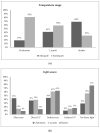Pet Reptiles-Are We Meeting Their Needs?
- PMID: 34679983
- PMCID: PMC8533019
- DOI: 10.3390/ani11102964
Pet Reptiles-Are We Meeting Their Needs?
Abstract
The ability to meet the needs of each species in captivity is at the heart of the ethical debate on the acceptability of keeping reptiles and other animals as pets. Little is known about the ability of reptile owners to understand their pets' behavior and to meet their welfare requirements. In this study, we surveyed pet reptile owners in Portugal (N = 220) to assess their behavioral knowledge and the provision of essential husbandry needs. Although two-thirds of respondents (68%) scored very good to excellent in terms of knowledge of their pet reptile's behaviors, only 15% of respondents met four essential reptile husbandry needs (temperature, lighting, diet and refuge) and 43% met two or less. None of the respondents reported their reptile's welfare as very poor, and only a single respondent reported it as poor. Logistic regression model showed that while snake owners had fourteen times higher odds of reporting adequate husbandry provision, lizard owners had the highest odds of reporting good or very good welfare despite providing less of their animals' basic husbandry needs. These results suggest that many pet reptiles in Portugal live in, at best, 'controlled deprivation' and are at risk of suffering poor welfare throughout their captive lives. Moreover, behaviors indicative of poor welfare and captivity stress were considered 'normal' by up to one quarter of respondents. We suggest that the frequency of these behaviors in pet reptiles has led to their acceptance as normal, precluding the search for ways to prevent them. These results suggest that campaigns aimed at challenging the current norm for adequate reptile welfare are warranted.
Keywords: animal welfare; behavior; chelonians; companion animals; controlled deprivation; exotics; lizards; reptiles; snakes.
Conflict of interest statement
A.A. and M.W. declare no conflict of interest. L.G. is currently member of staff at Exoclinic-Clínica Veterinária, Algés, Portugal. J.F. is Clinical Director of Centro Veterinário de Exóticos do Porto, Porto, Portugal, and was not directly involved in recruiting survey participants. M.M.-S. is supported by the research project
Figures


Similar articles
-
Keeping reptiles as pets in Brazil: keepers' motivations and husbandry practices.J Ethnobiol Ethnomed. 2023 Oct 21;19(1):46. doi: 10.1186/s13002-023-00618-z. J Ethnobiol Ethnomed. 2023. PMID: 37865770 Free PMC article.
-
Pet management practices of frog and turtle owners in Victoria, Australia.Vet Rec. 2022 Dec;191(12):e2180. doi: 10.1002/vetr.2180. Epub 2022 Sep 10. Vet Rec. 2022. PMID: 36087063
-
Risk for zoonotic Salmonella transmission from pet reptiles: A survey on knowledge, attitudes and practices of reptile-owners related to reptile husbandry.Prev Vet Med. 2017 Oct 1;146:73-78. doi: 10.1016/j.prevetmed.2017.07.014. Epub 2017 Jul 25. Prev Vet Med. 2017. PMID: 28992930
-
Future of keeping pet reptiles and amphibians: towards integrating animal welfare, human health and environmental sustainability.Vet Rec. 2017 Oct 28;181(17):450. doi: 10.1136/vr.104296. Epub 2017 Oct 19. Vet Rec. 2017. PMID: 29051315 Review.
-
Given the Cold Shoulder: A Review of the Scientific Literature for Evidence of Reptile Sentience.Animals (Basel). 2019 Oct 17;9(10):821. doi: 10.3390/ani9100821. Animals (Basel). 2019. PMID: 31627409 Free PMC article. Review.
Cited by
-
Influence of enclosure design on the behaviour and welfare of Pogona vitticeps.PLoS One. 2025 Jun 5;20(6):e0322682. doi: 10.1371/journal.pone.0322682. eCollection 2025. PLoS One. 2025. PMID: 40472003 Free PMC article.
-
Developing guidelines for pet rat housing through expert consultation.Vet Rec. 2023 Feb;192(3):e1839. doi: 10.1002/vetr.1839. Epub 2022 Jul 16. Vet Rec. 2023. PMID: 35841618 Free PMC article.
-
Bacterial, Fungal, and Parasitic Zoonoses.Pathogens. 2023 Dec 19;13(1):5. doi: 10.3390/pathogens13010005. Pathogens. 2023. PMID: 38276151 Free PMC article.
-
Mobile Zoos and Other Itinerant Animal Handling Events: Current Status and Recommendations for Future Policies.Animals (Basel). 2023 Jan 6;13(2):214. doi: 10.3390/ani13020214. Animals (Basel). 2023. PMID: 36670754 Free PMC article.
-
Keeping reptiles as pets in Brazil: keepers' motivations and husbandry practices.J Ethnobiol Ethnomed. 2023 Oct 21;19(1):46. doi: 10.1186/s13002-023-00618-z. J Ethnobiol Ethnomed. 2023. PMID: 37865770 Free PMC article.
References
-
- Pasmans F., Bogaerts S., Braeckman J., Cunningham A.A., Hellebuyck T., Griffiths R.A., Sparreboom M., Schmidt B.R., Martel A. Future of Keeping Pet Reptiles and Amphibians: Towards Integrating Animal Welfare, Human Health and Environmental Sustainability. Vet. Rec. 2017;181:450. doi: 10.1136/vr.104296. - DOI - PubMed
-
- Warwick C., Steedman C., Jessop M., Arena P., Pilny A., Nicholas E. Exotic Pet Suitability: Understanding Some Problems and Using a Labeling System to Aid Animal Welfare, Environment, and Consumer Protection. J. Vet. Behav. 2018;26:17–26. doi: 10.1016/j.jveb.2018.03.015. - DOI
-
- Warwick C., Arena P., Lindley S., Jessop M., Steedman C. Assessing Reptile Welfare Using Behavioural Criteria. Practice. 2013;35:123–131. doi: 10.1136/inp.f1197. - DOI
Grants and funding
LinkOut - more resources
Full Text Sources
Miscellaneous

